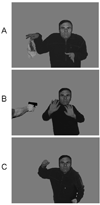Impaired integration of emotional faces and affective body context in a rare case of developmental visual agnosia
- PMID: 21482423
- PMCID: PMC3139796
- DOI: 10.1016/j.cortex.2011.03.005
Impaired integration of emotional faces and affective body context in a rare case of developmental visual agnosia
Abstract
In the current study we examined the recognition of facial expressions embedded in emotionally expressive bodies in case LG, an individual with a rare form of developmental visual agnosia (DVA) who suffers from severe prosopagnosia. Neuropsychological testing demonstrated that LG's agnosia is characterized by profoundly impaired visual integration. Unlike individuals with typical developmental prosopagnosia who display specific difficulties with face identity (but typically not expression) recognition, LG was also impaired at recognizing isolated facial expressions. By contrast, he successfully recognized the expressions portrayed by faceless emotional bodies handling affective paraphernalia. When presented with contextualized faces in emotional bodies his ability to detect the emotion expressed by a face did not improve even if it was embedded in an emotionally-congruent body context. Furthermore, in contrast to controls, LG displayed an abnormal pattern of contextual influence from emotionally-incongruent bodies. The results are interpreted in the context of a general integration deficit in DVA, suggesting that impaired integration may extend from the level of the face to the level of the full person.
Copyright © 2011 Elsevier Srl. All rights reserved.
Figures








References
-
- Adolphs R. Perception and emotion. Current Directions in Psychological Science. 2006;15(5):222–226.
-
- Adolphs R, Tranel D. Amygdala damage impairs emotion recognition from scenes only when they contain facial expressions. Neuropsychologia. 2003;41(10):1281–1289. - PubMed
-
- Anaki D, Kaufman Y, Freedman M, Moscovitch M. Associative (prosop) agnosia without (apparent) perceptual deficits: a case-study. Neuropsychologia. 2007;45(8):1658–1671. - PubMed
-
- Ariel R, Sadeh M. Congenital visual agnosia and prosopagnosia in a child: a case report. Cortex. 1996;32(2):221–240. - PubMed
Publication types
MeSH terms
Grants and funding
LinkOut - more resources
Full Text Sources

